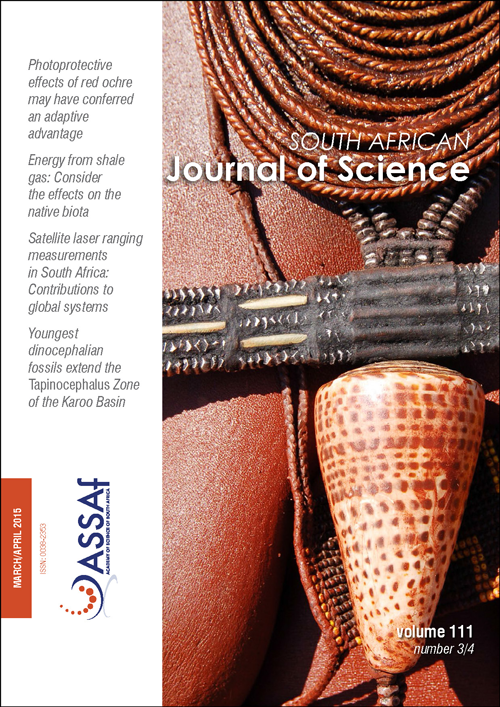Youngest dinocephalian fossils extend the Tapinocephalus Zone, Karoo Basin, South Africa
DOI:
https://doi.org/10.17159/sajs.2015/20140309Keywords:
Tapinocephalus, Middle Permian, Abrahamskraal, biostratigraphy, PristerognathusAbstract
The dinocephalians (Synapsida, Therapsida) were one of the dominant tetrapod groups of the Middle Permian (Guadalupian Epoch, ~270–260 million years ago) and are most abundantly recorded in the Tapinocephalus Assemblage Zone (AZ) of the Main Karoo Basin, South Africa. Dinocephalians are thought to have become extinct near the top of the Abrahamskraal Formation of the Beaufort Group and their disappearance is one criterion used to define the base of the overlying Pristerognathus AZ. Because of the abundance of fossils in the Karoo, the Beaufort Group biozones form the biostratigraphic standard for later Permian terrestrial tetrapod ecosystems, so their stratigraphic delineation is of great importance to Permian palaeobiology. We report two new specimens of the rare tapinocephalid dinocephalian Criocephalosaurus from the lowermost Poortjie Member, which makes them the youngest dinocephalians known from the Main Karoo Basin and extends the Tapinocephalus AZ from the Abrahamskraal Formation up into the Teekloof Formation. The extension of the Tapinocephalus AZ relative to the lithostratigraphy potentially affects the biozone or biozones to which a fossil species can be attributed; this extension has implications for biostratigraphic correlations within the Main Karoo Basin as well as with other basins across Gondwana. These discoveries also indicate that a population of herbivorous tapinocephalids survived as rare constituents of the tetrapod fauna after most generic richness within the clade had already been lost.
Published
Issue
Section
License

All articles are published under a Creative Commons Attribution 4.0 International Licence
Copyright is retained by the authors. Readers are welcome to reproduce, share and adapt the content without permission provided the source is attributed.
Disclaimer: The publisher and editors accept no responsibility for statements made by the authors
How to Cite
- Abstract 802
- PDF 576
- EPUB 197
- XML 349












.png)